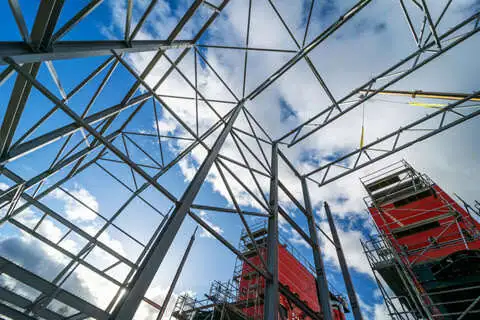Steel and Aluminum Structures

Steel and Aluminum Structures includes a series of standards that are specialized for manufacturing characteristics as well as structural design characteristics.
DIN EN 1090-1:2012
Execution of steel structures and aluminium structures - Part 1: Requirements for conformity assessment of structural components; German version EN 1090-1:2009+A1:2011
This European Standard specifies requirements for conformity assessment of performance characteristics for structural steel and aluminium components as well as for kits placed on the market as construction products. The conformity assessment covers the manufacturing characteristics, and where appropriate the structural design characteristics. This European Standard covers also the conformity assessment of steel components used in composite steel and concrete structures.
DIN EN 1090-2:2018
Execution of steel structures and aluminium structures - Part 2: Technical requirements for steel structures; German version EN 1090-2:2018
This European Standard specifies requirements for execution of structural steelwork as structures or as manufactured components, produced from hot rolled, structural steel products up to and including grade S690; cold formed components and sheeting up to and including grades S700; hot finished and cold formed austenitic, austenitic-ferritic and ferritic stainless steel products; hot finished and cold formed structural hollow sections, including standard range and custom-made rolled products and hollow sections manufactured by welding.
DIN EN 1090-3:2019
Execution of steel structures and aluminium structures - Part 3: Technical requirements for aluminium structures; German version EN 1090-3:2019
This European Standard specifies requirements for the execution of aluminium structural components and structures made from:a) rolled sheet, strip and plate;b) extrusions;c) cold drawn rod, bar and tube;d) forgings;e) castings.NOTE 1 The execution of structural components is referred to as manufacturing, in accordance with EN 1090-1.This European Standard specifies requirements independent of the type and shape of the aluminium structure, and this European Standard is applicable to structures under predominantly static loads as well as structures subject to fatigue. It specifies requirements related to the execution classes that are linked with consequence classes.NOTE 2 Consequence classes are defined in EN 1990.NOTE 3 Recommendations for selection of execution class in relation to consequence class are given in EN 1999-1-1.This European Standard covers components made of constituent products with thickness not less than 0,6 mm for welded components not less than 1,5 mm.This European Standard applies to structures designed according to the relevant parts of EN 1999. If this European Standard is used for structures designed according to other design rules or used for other alloys and tempers not covered by EN 1999, a judgement of the reliability elements in these design rules should be made.This European Standard specifies requirements for surface preparation prior to application of a protective treatment, and gives guidelines for application for such treatment in an informative annex.This European Standard gives options for specifying requirements to match project specific requirements.This European Standard is also applicable to temporary aluminium structures.
DIN EN 1090-4:2020
Execution of steel structures and aluminium structures - Part 4: Technical requirements for cold-formed structural steel elements and cold-formed structures for roof, ceiling, floor and wall applications; German version EN 1090-4:2018
This European Standard specifies requirements for the execution, i.e. the manufacture and the installation, of cold-formed structural steel members and sheeting and cold-formed structures for roof, ceiling, floor, wall and cladding applications. This European Standard applies to structures designed according to the EN 1993 series. This European Standard applies to structural members andsheeting to be designed according to EN 1993-1-3. This European Standard may be used for structures designed according to other design rules provided that conditions for execution comply with them and any necessary additional requirements are specified. This European Standard also specifies requirements for the execution i.e. the manufacture and the installation of structures made from cold formed profiled sheeting for roof, ceiling, floor and wall applications under predominately static loading or seismic loading conditions and their documentation. This European Standard covers sheeting of structural classes I and II according to EN 1993-1-3 used in structures. This European Standard covers structural members of all structural classes according to EN 1993-1-3.
DIN EN 1090-5:2020
Execution of steel structures and aluminium structures - Part 5: Technical requirements for cold-formed structural aluminium elements and cold-formed structures for roof, ceiling, floor and wall applications; German version EN 1090-5:2017
This European Standard specifies requirements for the execution i.e. the manufacture and the installation of cold-formed structural aluminium components made from profiled sheeting for roof, ceiling, floor and wall applications under predominately static loading conditions or seismic loading conditions and their documentation. It does cover products of structural class I and II according to EN 1999-1-4 used in structures. Structural elements are understood here to mean profiled sheeting, such as trapezoidal, sinusoidal, liner trays or cassette profiles (Figure 1), that are produced by cold forming. Perforated and micro profiled sheeting are also covered by this part. Welded sections are excluded from this part and are covered by EN 1090-3 except seal welding in low-stress areas. This standard also covers spacer constructions between the outer and inner or upper and lower skins as well as supporting members for roofs, walls and ceilings made from cold-formed profiled sheeting and the connections and attachments of the afore mentioned elements as long as they are involved in load transfer, it also covers connections and attachments of these elements. A combination of steel and aluminium structural elements are permitted, e. g. liner trays made of steel, stiffened by profiles made of aluminium. In this case, EN 1090-4 and this document apply. Composite structuralelements where the interaction between dissimilar materials are an integral part of the structural behaviour such as sandwich panels and composite floors are not covered by this standard.





